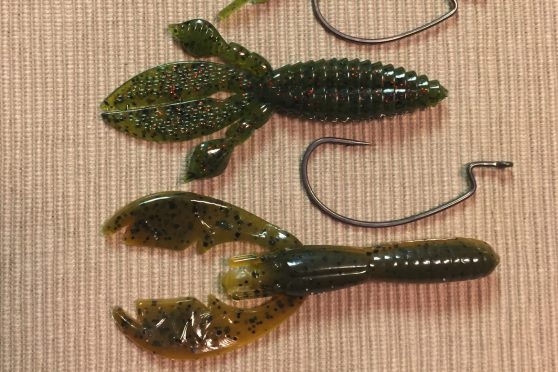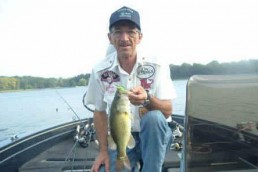The Pressure is On: Bassin’ Summer Waters
SHARE THIS POST
I’ve always considered July to be the heart of summer that kicks off the month with the biggest outdoor celebration of the year with The Fourth of July. And then there are the vacations, cottage visits and cookouts. This part of the season probably peaks the usage for on- and near-water activities.
While boats and personal watercraft churn up the surface on larger bodies of water, kayaks, canoes, radio-controlled boats, “picnickers” and a host of activities assault the banks for many bassers. Other bank anglers are now out in full force, and some are not so “bass-friendly” when it comes to etiquette, making excessive noise and disturbances. I’m not saying it’s wrong, as everyone has the right to enjoy the outdoors in their own way, but I’ve seen a pretty good fish bite flatline before because of too much commotion from nearby bank anglers. But you have the right to fish, play bags, crank up the music and skip rocks across the surface.
I’ve talked to some anglers who feel the weather—the heat in particular—is to blame for the drop in fishing success. In all reality, these fish are just so heavily pressured from all the bankside activities that their “normal” patterns have been altered. We’re going to focus on waters that receive not only an increase from other bank anglers, but also from the non-angling public. Simplicity and patience becomes the keys to success at this point, so let’s take a look at a couple simple approaches to home in on those “unsociable” bass of the summer.

First, for fishing pressure and its effects on bass, the non-angling activity of the season I believe is pretty understandable—fish are just bombarded with so many unfamiliar sights and sounds that part of the equation is predictable. Walk the banks, spook a decent fish, and what do they do? They simply move out to deeper water. The activities now have the same effect; the bass just move or retreat to the serenity of deeper water or learn to bury themselves in deep cover. While they can find rest in these underwater sanctuary areas, they still need to feed. And due to the warm-water temperatures, they feed often.
So, what are the other reasons why they have seem to have shut down their bite now? Well, they really haven’t. For example, on a lake that receives thousands of casts from other bank anglers, I believe these fish just become conditioned toward the usual go-to baits most bank anglers throw at them. Baits that rattle, wobble, flash, you name it, are seen so often that fish just begin to ignore them. You can connect on some occasions, but for the most part, they have become ineffective.
Fishing around the Chicago area, heavily pressured lakes are pretty much a common occurrence. You need to adjust, learn to go home frustrated or hang up the gear for a more favorable time of year.
Let’s adjust.
While there are many areas bass can go to get away from the crowds, I’m focusing on a couple familiar ones that you should be able to find in most bass waters in the Midwest. The first is deep water. From the days of the teachings of Buck Perry, “The Father of Structure Fishing,” the home of big bass was and still is found in deep water. Some waters, especially some man-made lakes, there are structure-free depths but the fish will summer there if pressured from above. And if you can find some deep water with some bottom structure like rocks, wood or other types of debris, so much the better.
What I look for on most lakes is some type of weeds that extend toward deep water. Scattered weed clumps or beds are ideal for this type of fishing and offer bass the perfect underwater summer hangout with not only deep water, but also areas closer to the weeds.
So why not fish the bass a little shallower under heavy weed mats?
Are you enjoying this post?
You can be among the first to get the latest info on where to go, what to use and how to use it!
The concept of pulling bass from these locations is understandable. And yes, big fish are there. But the issue for the bank angler becomes getting these fish out of the weeds. You can get a heavy-punch bait through the weed mat, but with so many thick weeds, even if you’re using heavy braid it’s often difficult or impossible for one to move the bass and weeds toward the shoreline. It’s a much more effective strategy to just get the fish to come straight up, rather than all the way back through the weeds to shore. Trust me—I’ve frustrated myself trying.
With the bass whereabouts kind of dialed in, how about presentations?
Don’t overthink this. While I might carry a few hard baits for a just-in-case situation, my rig and bait choices can all fit into a couple of Ziploc bags. And if I’m covering quite a bit of bank, they usually do.

My first rig for heavily pressured waters that’s nothing new to most bass anglers is the drop-shot rig. It’s a staple finesse approach for bass fishing, but this time of year it just flat out catches fish. I fish my drop-shot rig on a spinning rod with 8-pound-test line. Even though I might be close to weeds near the bass, I don’t want to give up the bait’s action by going to a heavier line. This is where 8-pound test is ideal.
Next is the hook; this is a critical part of the rig. The market is full with designated drop-shot hooks, but I’ve been using VMC’s Spinshot Drop Shot Hooks in sizes 2 and 4. (See rig in the accompanying pic). As far as a weight, you can choose a standard drop-shot weight or a simple large split shot. I fish on the heavier side with weights, but you can experiment.
As far as baits for drop-shotting, choose your favorite. My latest selections have been a couple of shorter but thick small worms. Strike King’s Fat Baby Finesse Worm, Zoom’s Finesse Worm and Swamp Crawler pretty much take care of my selections. Feel free to use the drop-shot minnows too, as they do work, but I have been experimenting with these heavier worms lately.
My other approach is a weightless rig with heavy, chunky, creature-type baits. My choices are Bass Pro Shop’s 4 1/2-inch River Bug, Strike King’s KVD Rodent and, my favorite, Net Bait’s 5-inch Paca Craw. My hooks are large and heavy, and I use the Berkley Fusion 19 Superline EWG in sizes 5/0, 6/0 and 7/0. I rig them Texas-style on heavy braid, from 30- to 65-pound test. I normally throw this rig on a baitcaster, rather than a spinning rod.
This tactic is similar to Senko fishing, but is a heavier setup and the baits spend more time on the bottom. With no weight other than that of the plastic bait and the hook, it’s a simple cast out toward the base of the weed cover. And with the slower decent, you’ll get many hits right before the bait hits the bottom, so pay attention on the drop. This rig will be weedless, so you can work around sparse weed cover with no problem. Also, don’t overexaggerate the action of these baits but simply crawl them over the bottom or through the weeds. Bass can see and hear these better than you think, so lots of hopping and quick jigging isn’t needed.
So when the bass head out of the shallows for their summer retreats, go knocking on their new “front doors” with this simple high-pressure technique. Remember, the key to finding these summer fish is through simplicity and patience.
MWO
SHARE THIS POST
You may also like...
0 CommentsInsider Secrets to Summer Bassin’ in Ozarks Lakes
Did you enjoy this post?
You can be among the first to get the latest info on where to go, what to use and how to use it!
Dan Brozowski
Passion for angling drives Dan Brozowski to the water’s edge virtually any chance he gets. Although passion cannot be measured, weighed, or recorded, it can be shared. He does this through his writing and while on the water. If you have any questions or comments for Dan, you may contact him at: onthebank@att.net.

